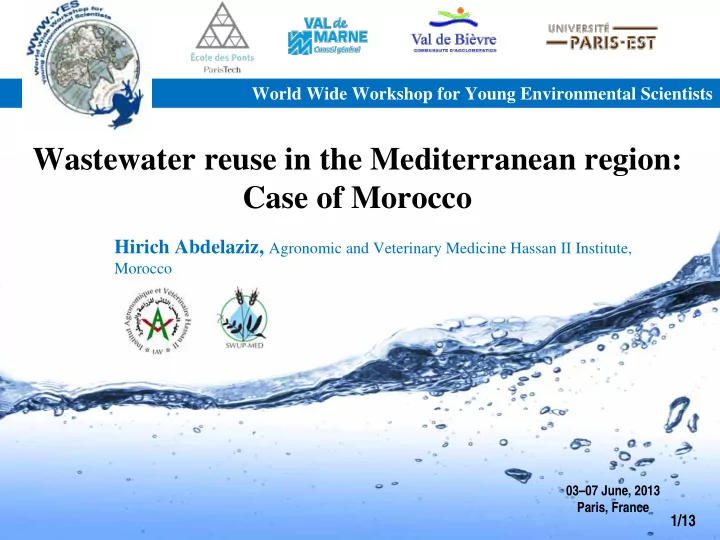

World Wide Workshop for Young Environmental Scientists Wastewater reuse in the Mediterranean region: Case of Morocco Hirich Abdelaziz, Agronomic and Veterinary Medicine Hassan II Institute, Morocco 03–07 June, 2013 Paris, France 1/13
Content Water scarcity and potential of wastewater in the Mediterranean region Driving forces for using treated wastewater Wastewater treatment in Morocco Wastewater reuse in Morocco Factors impeding the implementation of water reuse strategies in Med region 2/13
Water scarcity and potential of wastewater in the Mediterranean region Source: FAO, AQUASTAT, 2008. 3/13
Water scarcity and potential of wastewater in the Mediterranean region Water resources availability in Morocco 1971 1272 (m 3 /capita.yr) 1272 1982 980 980 1994 757 757 2000 688 688 2010 595 595 2020 508 508 4/13
Water scarcity and potential of wastewater in the Mediterranean region Wastewater % of Wastewater Treated/ % of Wastewater reused/ Country Produced Year of WWR Wastewater Produced Wastewater Produced 10 6 m 3 /yr Algeria 820.0 85.4 3.2 2011 Cyprus 30.0 100.0 83.3 2008 Egypt 4930.0 60.3 60.3 2001 France 7910.0 91.0 5.2 2004 Greece 719.0 62.6 1.0 2008 Israel 450.0 62.9 62.2 2008 Italy 7731.0 31.0 3.5 2008 Jordan 82.0 90.2 85.4 2010 Lebanon 249.0 1.6 0.8 1991 Libya 546.0 20.1 7.3 1999 Malta 19.0 79.3 50.0 2008 Monaco 7.3 82.5 0.0 2009 Morocco 700.0 25.3 11.4 2007 Palestine 50.0 53.8 20.0 2004 Slovenia 168.5 68.4 4.1 2009 Spain 5204.4 86.8 10.1 2008 Syria 825.0 66.7 66.7 2002 Tunisia 240.0 89.6 14.1 2001 Turkey 4289.0 57.9 23.3 2006 Total 34970.2 63.9 18.1 Source: Guardiola et al. 2011, WWR: wastewater reuse. 5/13
Water scarcity and potential of wastewater in the Mediterranean region Wastewater production in Morocco At national level At regional level Agadir city 47.000 m 3 /Day 78.000 m3 /Day 2000 2020 6/13
Driving Forces for Using Treated Wastewater Reduce pressure on naturel resources/ecosystems (quality and quantity) Cope with water demand (commmunities and ecosystem) Sustainable water supply Contribute to integrated water management Not affected by climate change 7/13
Driving Forces for Using Treated Wastewater Why treated urban wastewater? Compared to desalination, it is a cost-effective and energy saving to increase water supply and mitigate the impact of climate variability and climate change Reuse of treated wastewater means making a productive asset out of a waste production from which it is possible to recover heat, energy, nutrients and clean water (aqua environment) Different reuse opprtunities with social, economic and environmental values 8/13
Wastewater treatment in Morocco Primary clarifier Primary clarifier Aerobic Lagoons: Sand filter UV Disinfection System: tertiary treatment Anaerobic Lagoons: Biogas production Aerobic Lagoons: Sheafer system, Secondary treatment Anaerobic Lagoons: Primary treatment 9/13
Wastewater Reuse in Morocco • Agricultural irrigation • Golf course irrigation • Landscape irrigation in urban areas • Ground water recharge • Forest irrigation • Creation of wetlands • Industrial cooling system 10/13
Factors Impeding the Implementation of Water Reuse Strategies in Med Region Location, topography and 1 5 Pricing space Transportation of WW from 2 treatment plants to the point of use No clear guideline on 3 6 Maintenance allocating recycled water to different sectors Externalities: • Potential groundwater pollution; • Increase of soil salinity if 4 used for irrigation; Social awareness and 7 acceptability • Potential unknown ill effects if used for potable uses. 11/13
Question ? Irrigation with treated wastewater Tranformation If you already know that! will you consume that bread ? 12/13
Thanks for your attention! Questions ! hirich_aziz@yahoo.fr
Wastewater treatment in Treatment yield: Marrakech DBO5 > 95 % MES > 95 % Energy generating : 30 000 KWHe/day 30 000 KWHe/day
Raw Primary Secondary Standards Yield wastewaetr treatment treatment Suspended 700 380 14 50 98% matter BOD5 800 360 17 100 98% COD 1600 700 46 500 97% Fecal 3,7E + 07 4,3E + 06 80 (x) 1.000 7,0 ULog coliforms X after treatment with UV 15
Response of several crops to irrigation using treated wastewater Egg Bread Durum Treatments Chrysanthemum Zucchini Maize plant wheat wheat Flower/plant Kg/plant Kg/m² Qx/ha Qx/ha Qx/ha Control* 69 1.29 3.17 12.43 5.107 0 Treated 80 2.18 3.41 12.62 48.69 31.83 wastewater Economic gain from treated wastewaters irrigation Crops Net gain of water Benefit in fertilizers Total Benefit (DH/year.inhab)* (DH/year.inhab)** (DH/year.inhab) Tender wheat 750 1492 2242 Unground corn 1588 3614 5202 Fodder corn 1568 3572 5140 Clover (Berseem) 774 1539 2313 Zucchini 677 1545 2222 Marrow 611 1216 1827 Tomato 1553 3542 5095 Potato 940 2140 3080 16
Recommend
More recommend